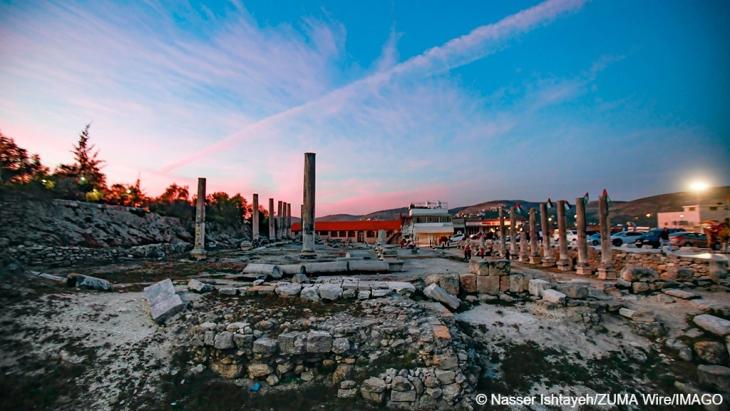Dispute about the site of biblical Samaria intensifies

Israelis – and in particular members of Israel's right-wing religious government – primarily associate the village of Sebastia with the biblical town of Samaria. Not only does the government reject the claim of the Palestinians, who have been living there for centuries, to the village's cultural heritage, it also wants to change the archaeological site according to its own ideas.
Sebastia is a small Palestinian village north-west of Nablus that harbours important cultural treasures. On its western edge are the archaeological remains of a palace from the Israelite Omrid period and a Byzantine church that is believed to be the burial place of St John the Baptist. There are also numerous structures from the Roman period, including a temple of Augustus, a hippodrome, a theatre and columns from a basilica.
The site is currently going through the process of being considered for UNESCO World Heritage Site status. It is located in the Israeli-occupied and fully Israeli-controlled Area C of the West Bank.
The site is reached via an access road and a large car park, which are situated in the Palestinian-administered Area B. When Israeli tourists, mostly settlers, visit the site, they are escorted by the military. In such cases, visitors from the Palestinian side have to make way for them. There is growing resistance to this situation, increasingly leading to clashes between Palestinians and Israeli soldiers.
1/2EU and like-minded visited the Palestinian town of Sebastia and its ancient archeological site. Interlocutors, including the mayor, briefed on the Palestinian cultural heritage of the site and the village’s conservation efforts. pic.twitter.com/Bo5ZHko4tK
— EU and Palestinians (@EUpalestinians) May 24, 2023
The road to UNESCO World Heritage Site status
Radical settlers have recently accused Palestinians of wilfully destroying archaeological treasures in the village. Although the evidence of such vandalism is extremely dubious, the new ultra-right Israeli government is more than willing to believe it.
Amichai Eliyahu, Heritage Minister and a member of the right-wing extremist Otzma Yehudit ("Jewish Strength") party, raised serious accusations on a recent visit to the site: "The people here are trying to wipe out the entire Jewish people. They want to erase the history of the people of Israel. And we are not going to stand for that."
Years ago, the Israelis declared the archaeological site a national park that is named after the ancient town of Samaria (Shomron in Hebrew), which is said to have been built in the ninth century BC by the biblical kings Omri and Achav of the Northern Kingdom of Israel. Samaria was, however, destroyed by Assyrian invaders just a few decades later.
The Palestinians, who consider themselves to be the original inhabitants of the area, claim the site as their own and call it Sebastia – after the town King Herod built here centuries later. They promote Sebastia as one of the most important archaeological sites in the Palestinian territories.
A museum that opened in the village in 2017 presents archaeological finds that come for the most part from rescue excavations in the village. Research excavations by Palestinian archaeologists both at the site and in the village itself are systematically prevented by the Israelis.

Mayor goes on the defensive
The Israeli government recently earmarked some €9 million for a development programme for the archaeological site. The Palestinians see this as a menace to their cultural heritage.
Speaking to the local radio station Hayat, Mayor Muhammad Azem condemned the "Judaisation project of the occupation authorities," which he said aimed to establish complete control over the archaeological site: "It should be open to visitors from all over the world. But the occupiers want to make the site accessible only to settlers, a dangerous development designed to create a new situation in Sebastia."
He says that the Israelis' plans include completely fencing off the site and building a new access road that would connect with the road leading to the neighbouring Israeli settlement of Shavei Shomron. Azem fears that, in a further step, the Israelis would also carry out excavations "to uncover traces of their, as they say, ancestors".
The Palestinian protest against the planned Israeli project was recently joined by a small delegation of EU diplomats who visited the site. German diplomat Sven von Burgsdorff, the EU's representative in the Palestinian territories, stressed in his statement that the territory and its cultural treasures belonged to the Palestinians alone.
Although Mayor Azem welcomes such gestures, he doubts that they will make much of an impression on the Israelis. He wants to try to take legal action against the construction plans by invoking the land rights of the villagers as recorded in old land register entries. Muhammad Azem hopes that this will at least delay the upcoming construction work.
© Qantara.de 2023
Translated from the German by Jennifer Taylor